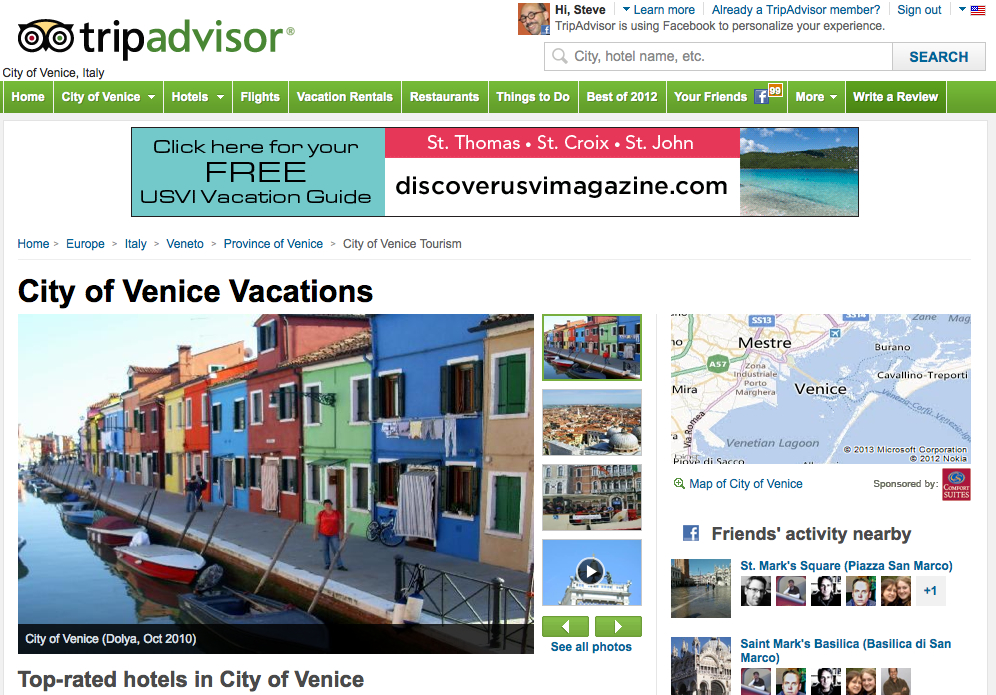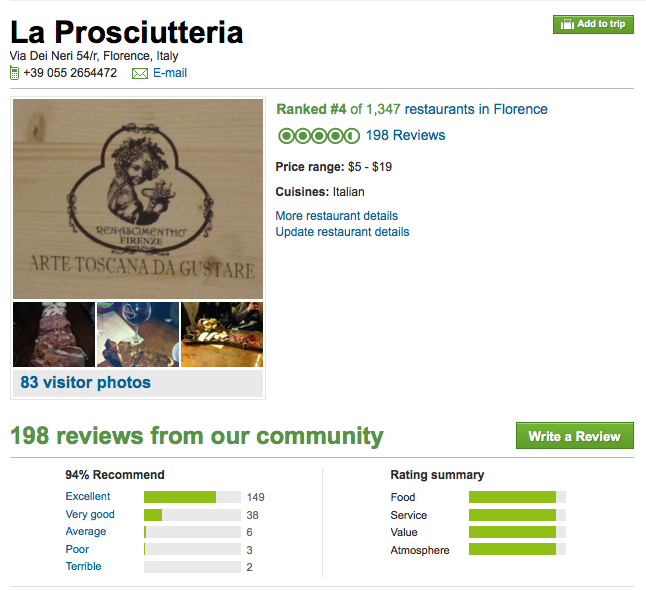
Traveling outside of the U.S., you quickly get a sense of just how much the Internet has changed how we gather and validate information. Our access to information, and how we use crowd knowledge has changed dramatically in a few short years.
In planning a trip to Italy with my family, I found myself embracing a wide range of information sources. A variety of form-factors, each with its own place in my knowledge gathering mission.
The family trip was to Italy, specifically Rome, Florence, and Venice. Ten days, two airplanes, two trains, and a ton of walking.
First, before departure, I gathered a collection of guide books from Lonely Planet and a large fold out map of each city -- the books for deep reading and the maps to layout on the dining room table and plot our journey. Then, a deep dive into Google maps to understand the distance from place to place, from hotel to train station, and the "walkablity" of cities like Rome, Florence and Venice. Finally, a pre-visit journey via Google street view to see what our various locations looked like, and how neighborhoods and streets felt as you virtually "walked" down them. Street view was a new tool in our arsenal.
Then, we booked again a mix of web, trip planner (europeandestinations.com) and human travel agents. And, finally, apps -- downloadable apps for each city, as well as language apps and translation apps. My wife and 15-year-old son and I did all this together, planning an itenierary, destinations, and travel from city to city -- airplane to Italy, trains from city to city, and then a flight out.
Once on the ground, I found two big changes in how the web has impacted travel.
First, TripAdvisor. My memory of TripAdvisor was that it was mostly a collection of unhappy travelers complaining about a hotel or restaurant they didn't like. But that was years ago, and boy has it changed. In Rome, TripAdvisor helped us find two of our three evening dinners -- with reviews from good natured fellow travelers who shared tips, favorite dishes, and warning about oddities. I found TripAdvisor to be 100 percent on point, allowing us to budget rather than be surprised at costs, and to go off the beaten trail. Sure, the hotel concierge was a help for booking, but from city to city, concierge were uneven (great in Rome, ok in Florence, unhelpful in Venice).
The combination of Trip Advisor and GPS navigation made it easier to explore outside of tourist zones, feel confident even when rather lost, and not be at the mercy of cab drivers or local tour guides.

TripAdvisor's community was so helpful, so warm, and so engaging that I did something I never expected to do, and ended up reviewing a number of restaurants while on the trip. In Rome, one restaurant was good, though more expensive than we'd expected (the concierge said 'reasonable') and they added a charge for the bread basket to the bill -- which seemed a bit surprising. A positive review with two warnings seemed like right bit of information to share with fellow TripAdvisor travelers.

And then there was an entirely new behavior. In the past, I've shot some pictures on a trip and shared them with a few firends and family on our return. This time, I took along a new Sony nex-5r, with a stunning 16 MP APS-C sensor, a small form-factor, and a light weight body. The result? Hundreds of pictures from each city -- most shot by my son. Again, with WiFi in each hotel, we uploaded, edited, and shared on Facebook. The result was a wonderful flow of comments, "likes," and suggestions from our friends of their favorite sites and restaurants. It was as if we took our shared community on vacation, got to share our experiences in almost real time, and to enjoy the social network feedback on a city by city basis.
A word about WiFi. Clearly vacationers want it and hotels and many restuants now offering it free. But don't expect that they fully understand why we need it. In Venice, at the otherwise wonderful Palazzo Selvadego (an affilaite of the Monaco Grand Canal) we were offered a single login and password. It was good for just one device we were told. When our son went and ask for two more log ins (we each had or own devices) the concerige seemed shocked that we would ever need so many logins. But, of course we did. To share, connect, and check email. WiFi is still a strange creature and while ubiquitous, it isn't understood -- yet. Also, charging devices is a bit of a trick. We brought converters for up to three devices, and had no problem in Rome. But at the otherwise warm and inviting Albini in Florence, there was only one outlet, tucked in the corner. In Venice, outlets a-plenty.
One final note about food. Away from home, trying new things is always a bit risky. It's why so many travelers end up in restaurants near major attractions. But with TripAdvisor and my friends advice, we were able to go down many alleys and explore local haunts far off the beat trail. The knowledge of the crowd made us more adventurous, and the result was both rewarding and delicious.
Technology is changing how we plan, share, and enjoy travel. And being connected to fellow travelers -- both actual friends, and the large community of visitors -- means there isn't as likely to be a tourist trap or unplanned expense or "fee" that is foist upon a first time visitor. It may happen, but if so, be assured that it will be posted on TripAdvisor to warn the next traveler who comes along.
Overall, tech is making travel safer, more fun, and easier to share and enjoy.
